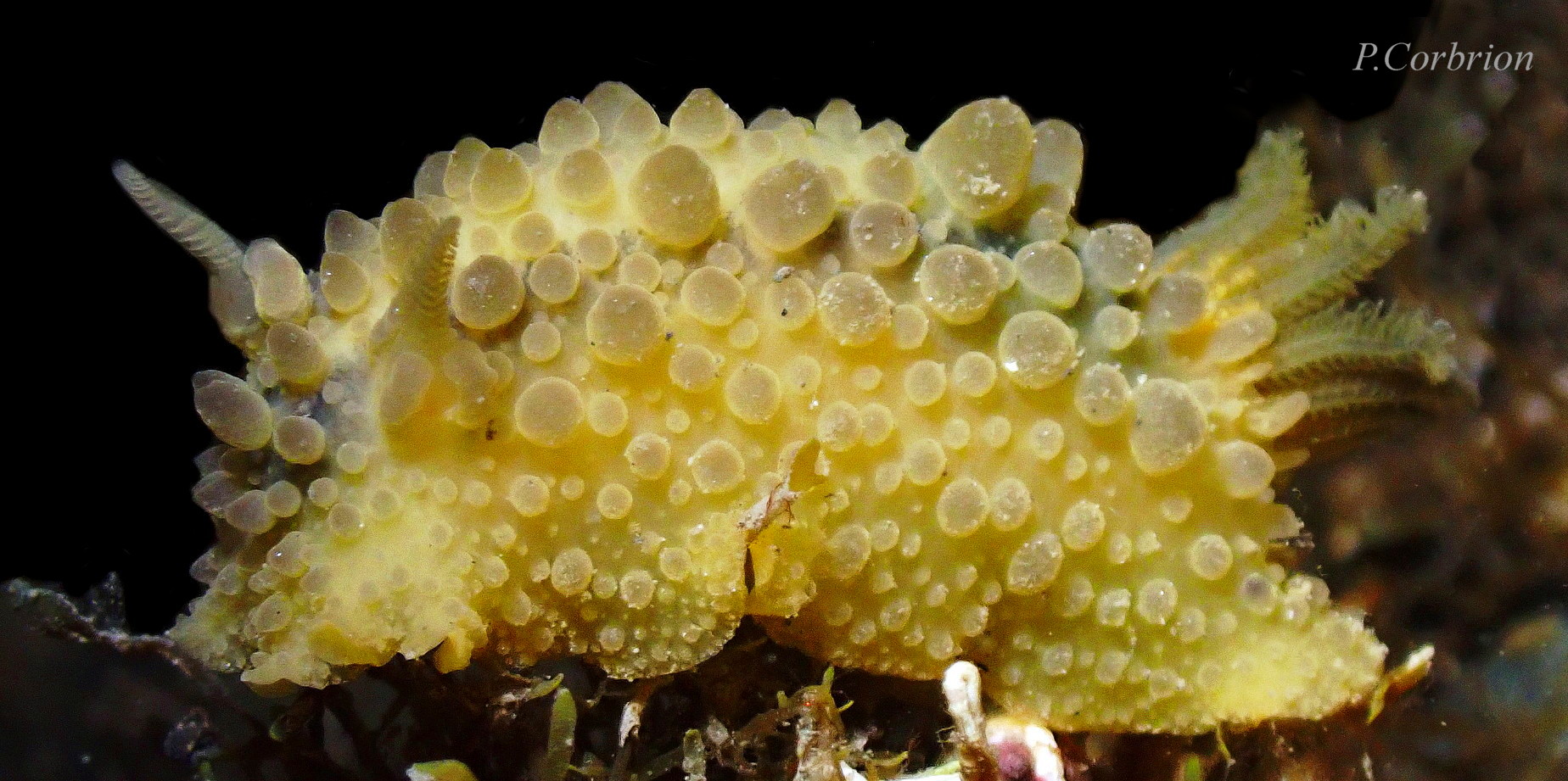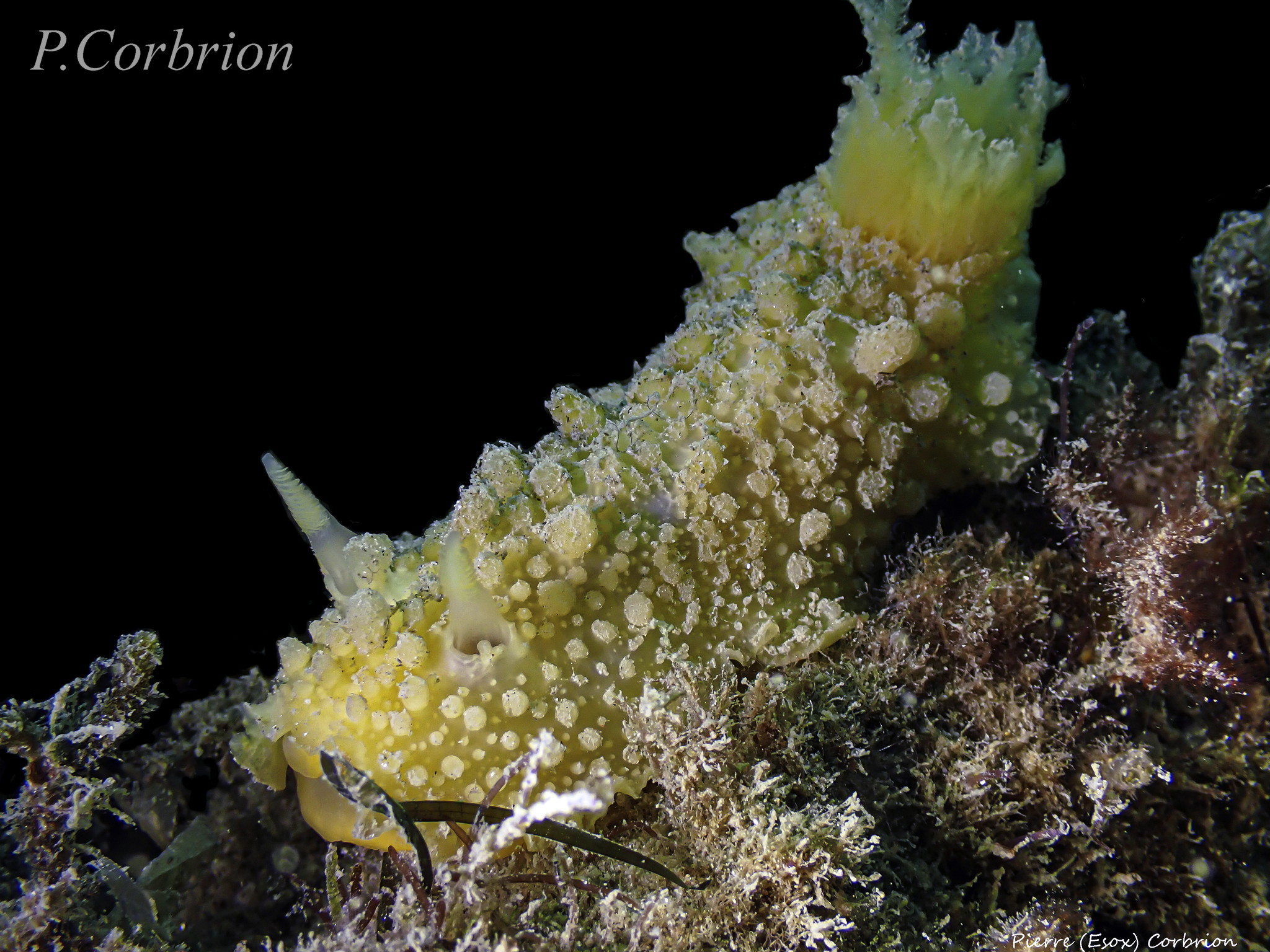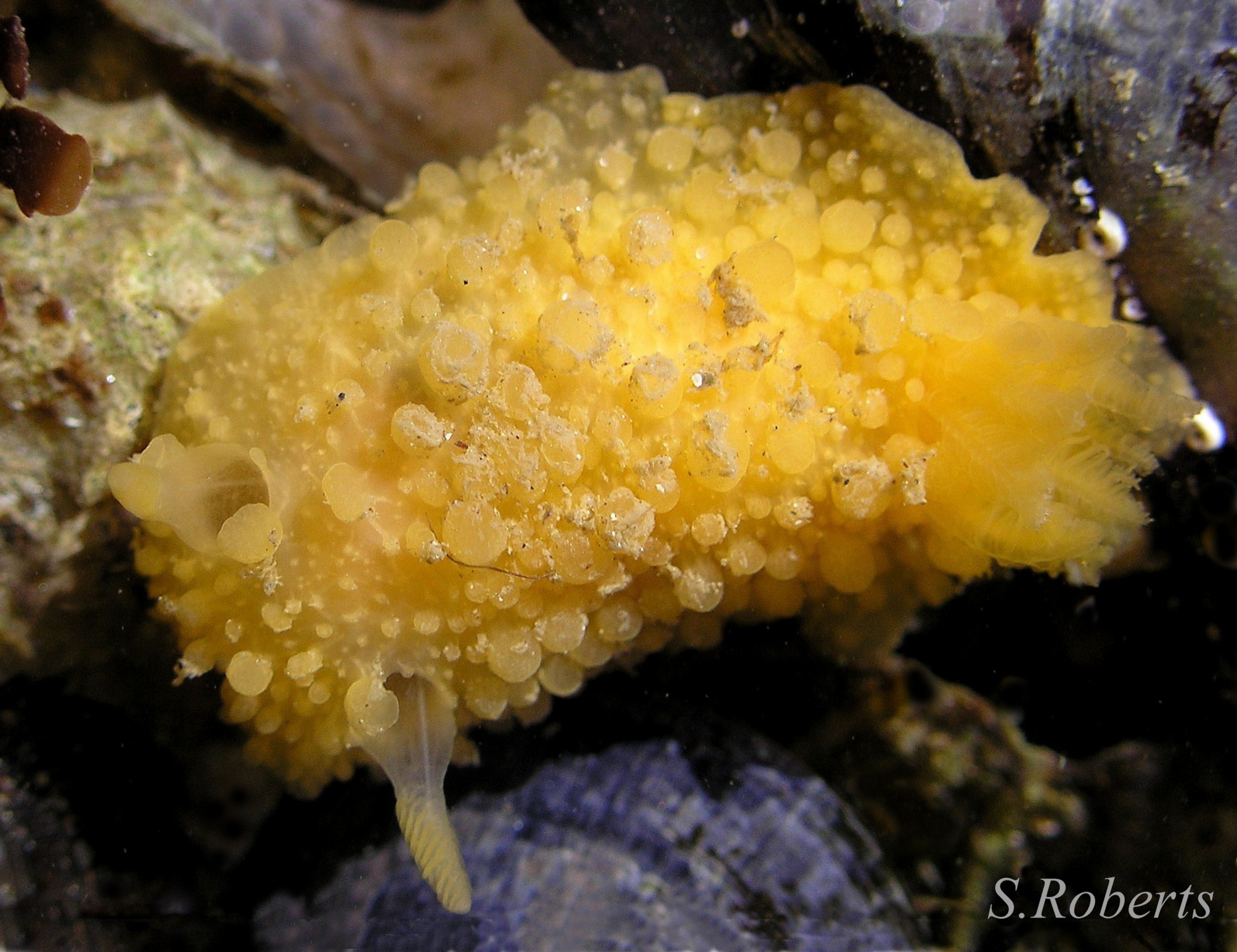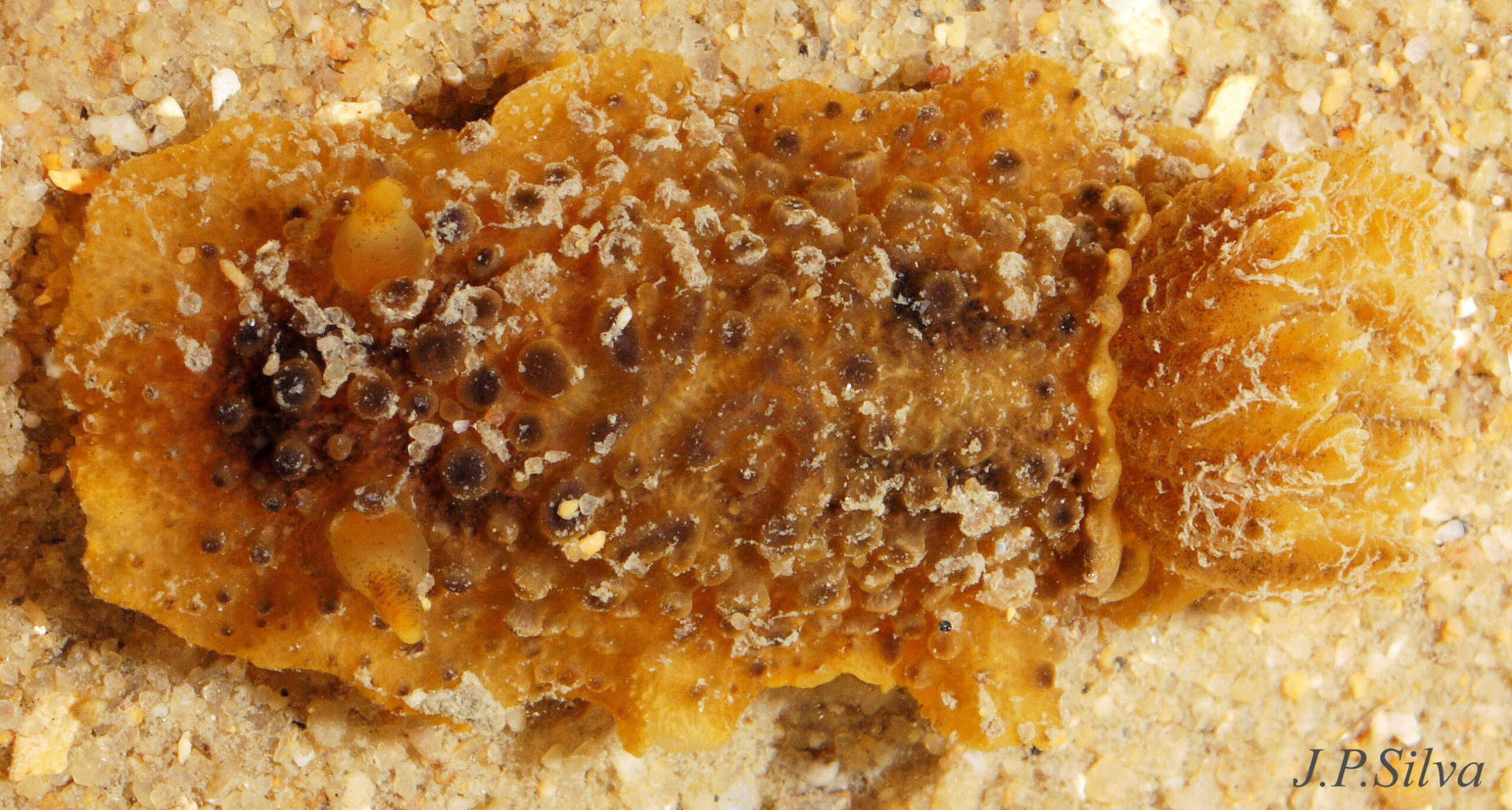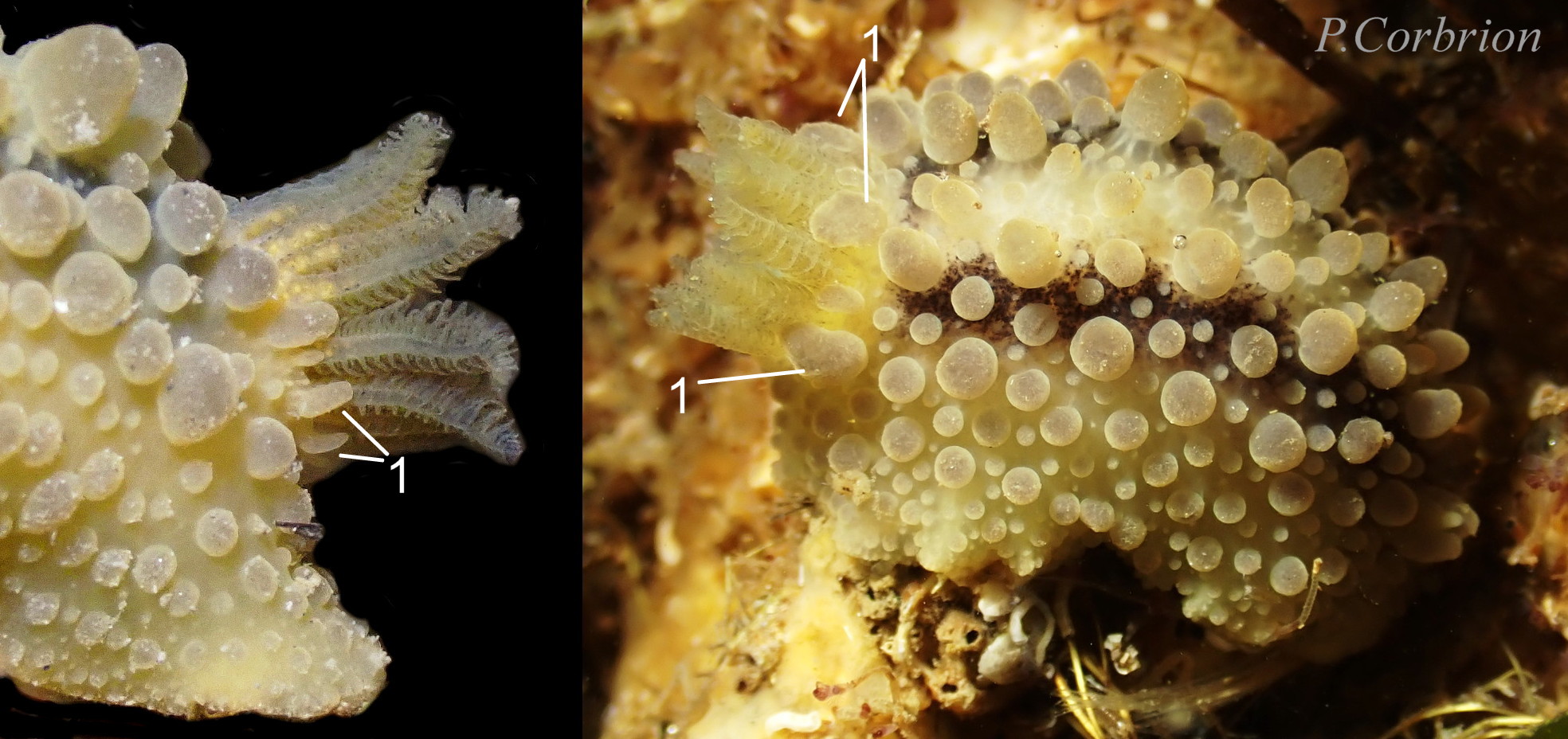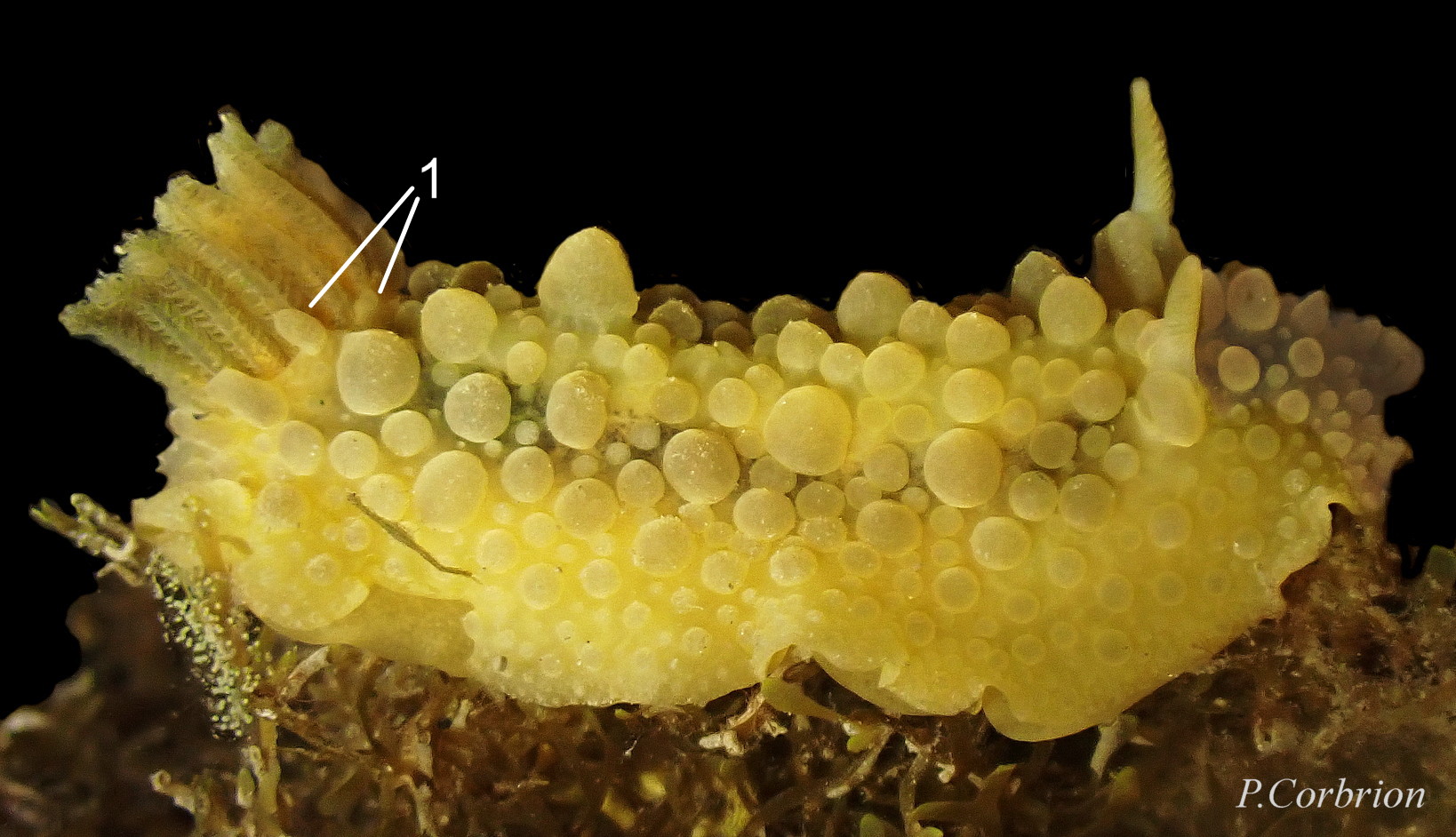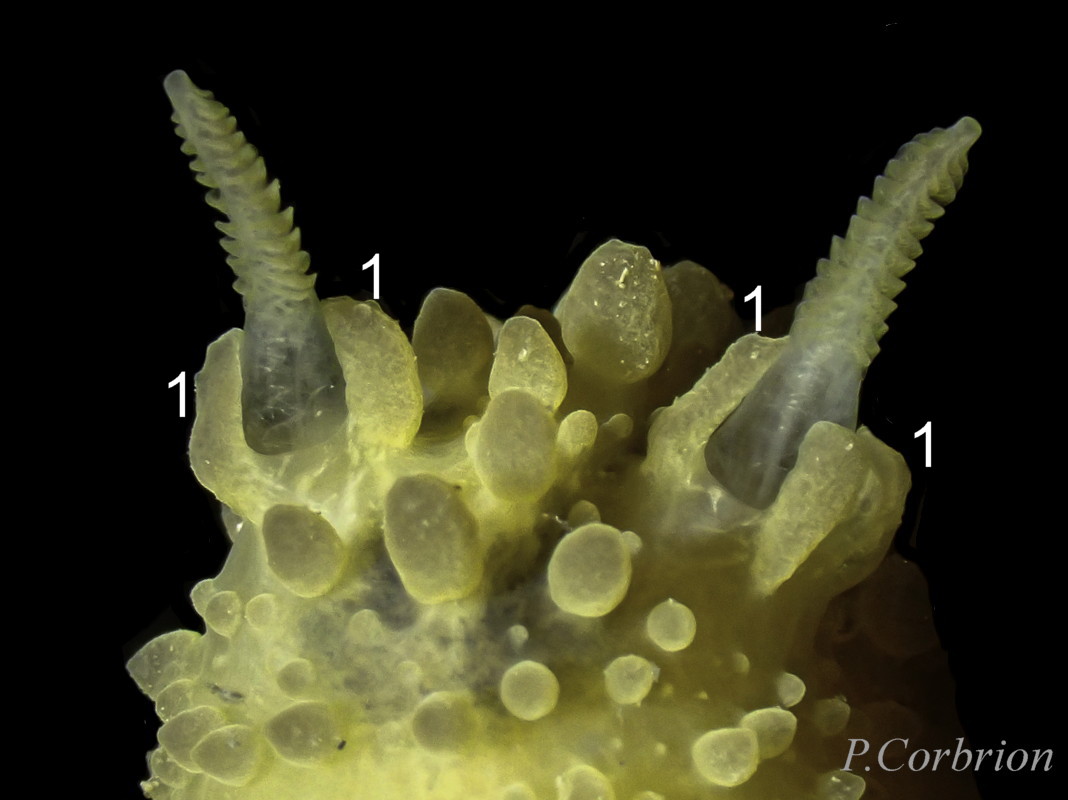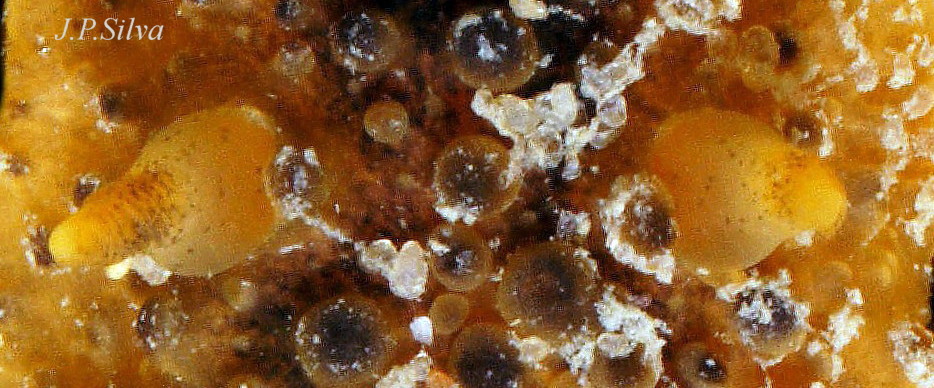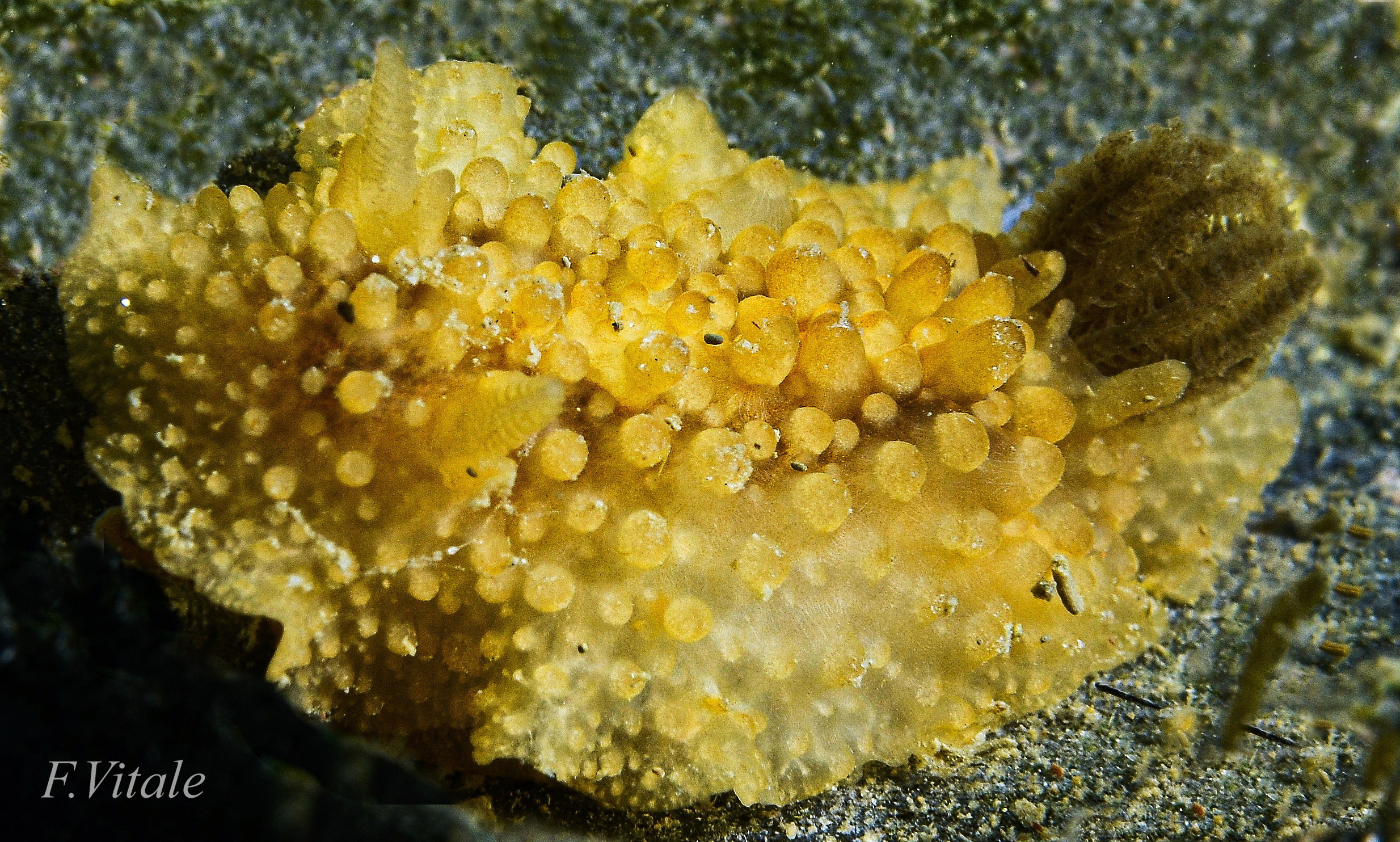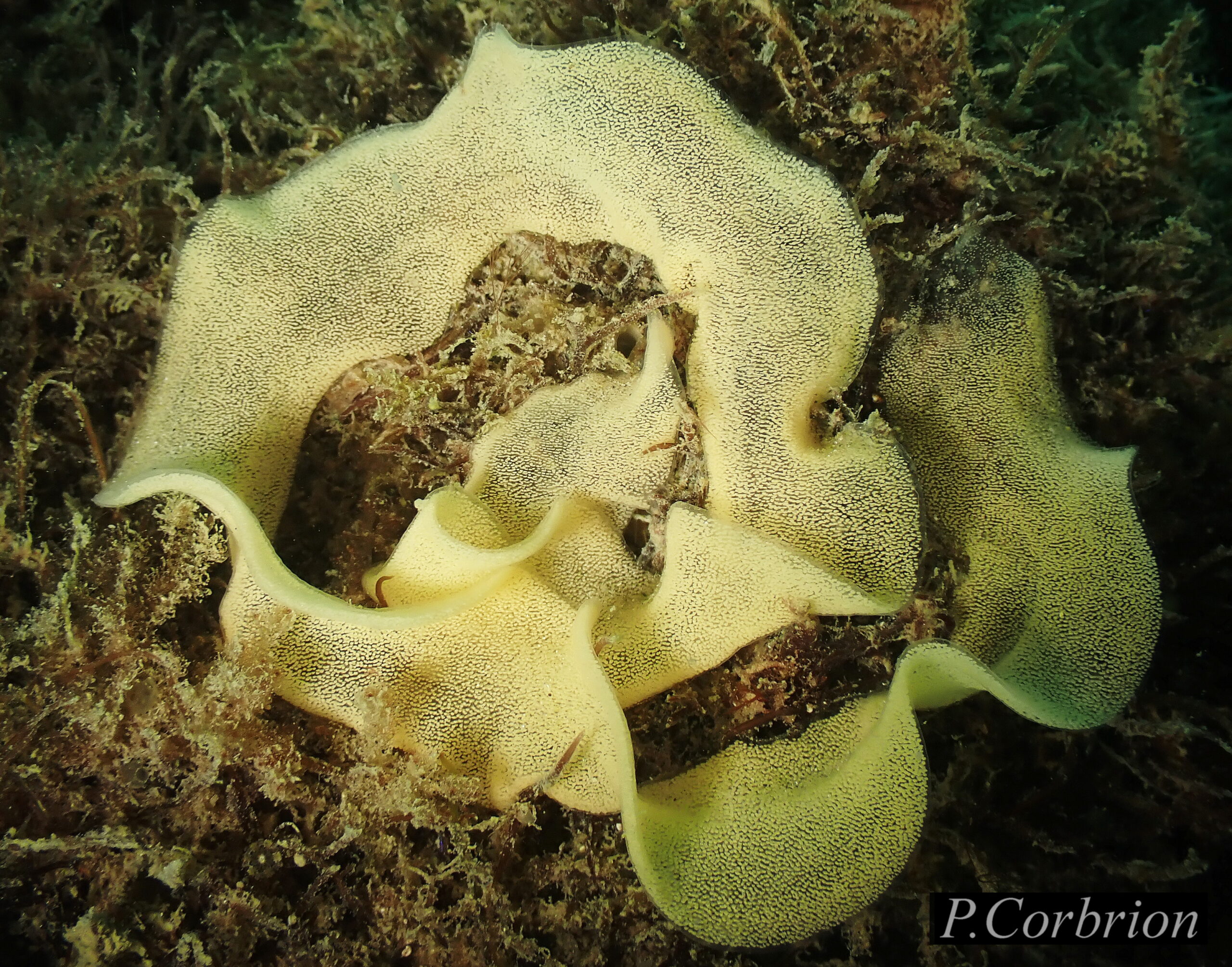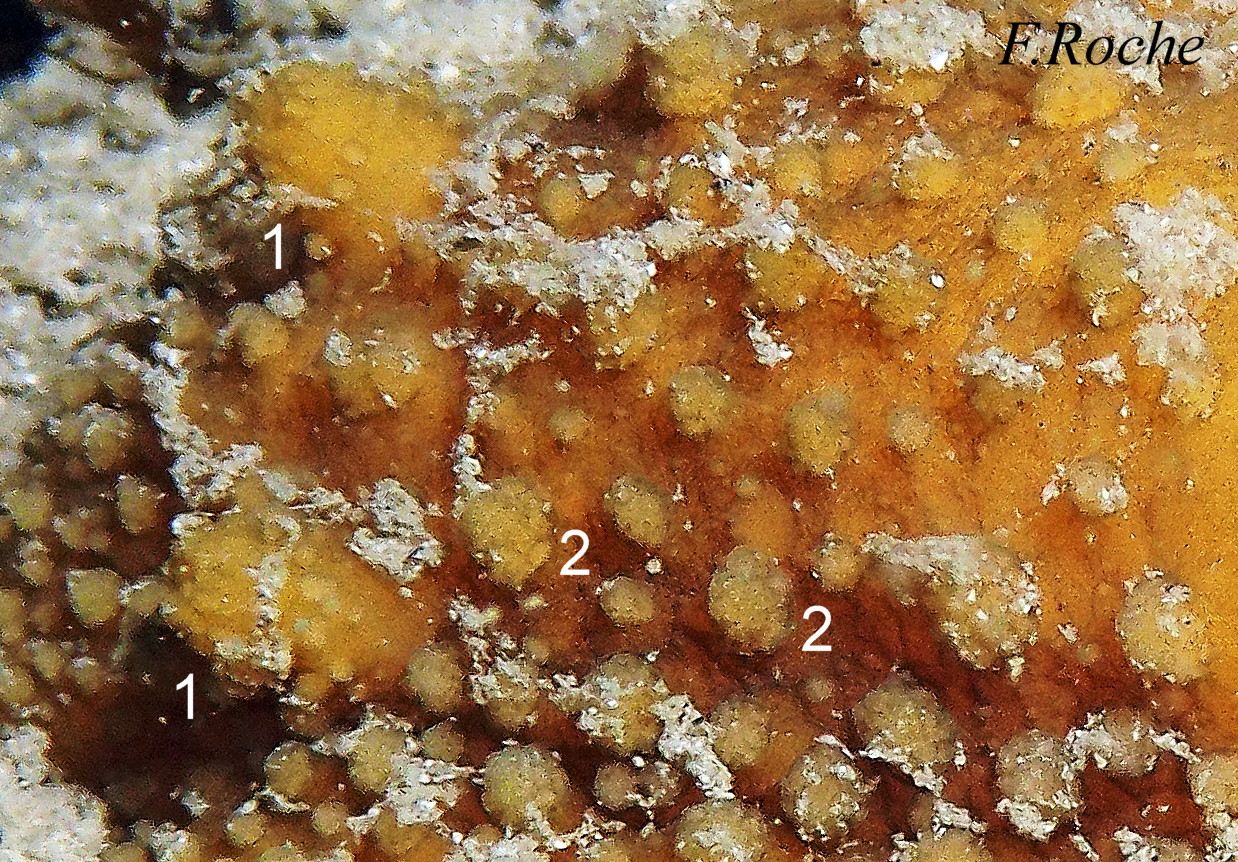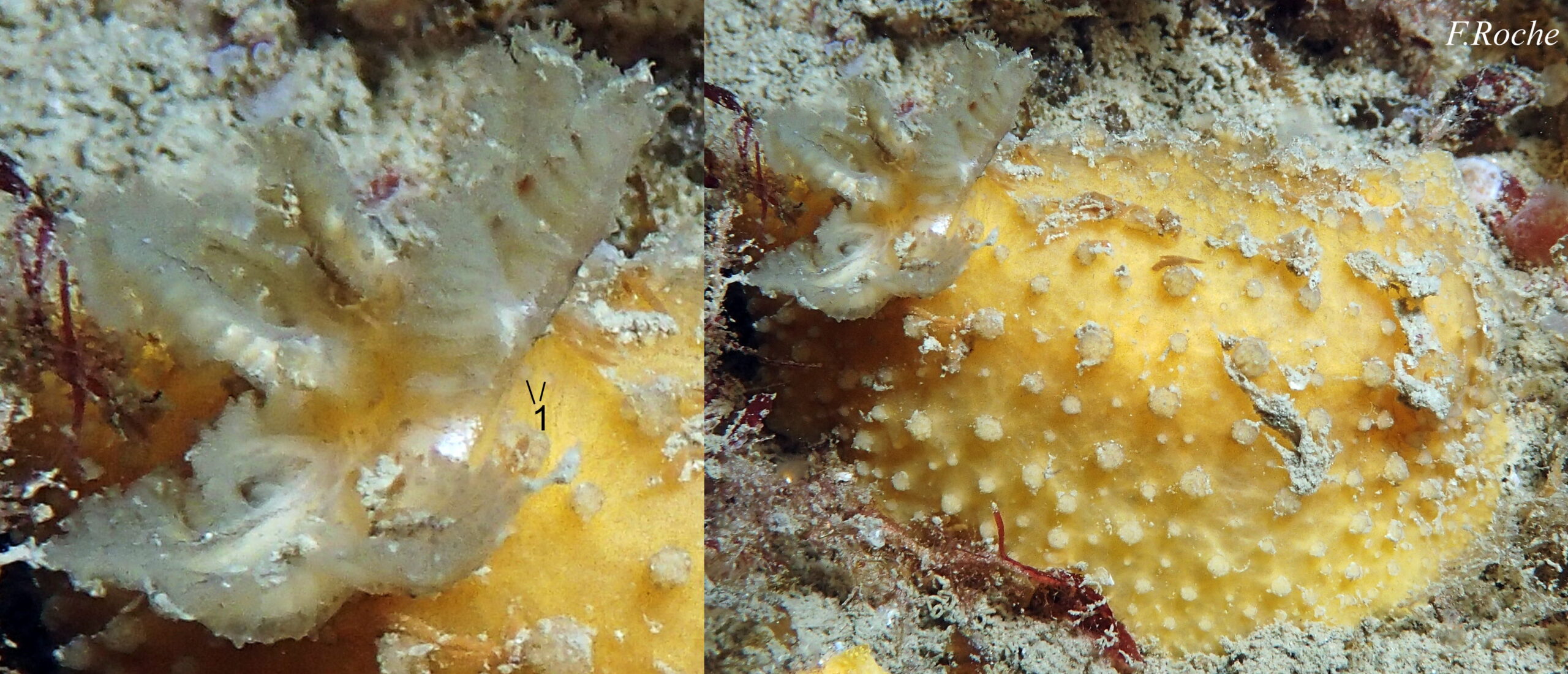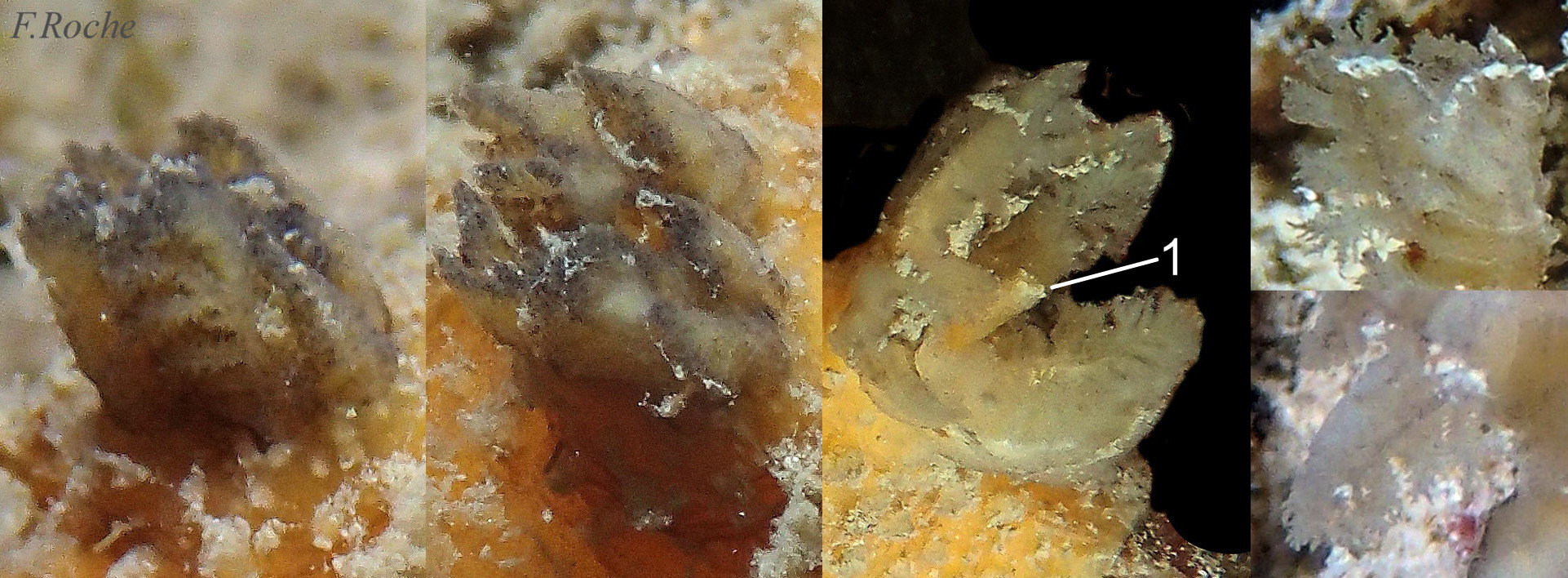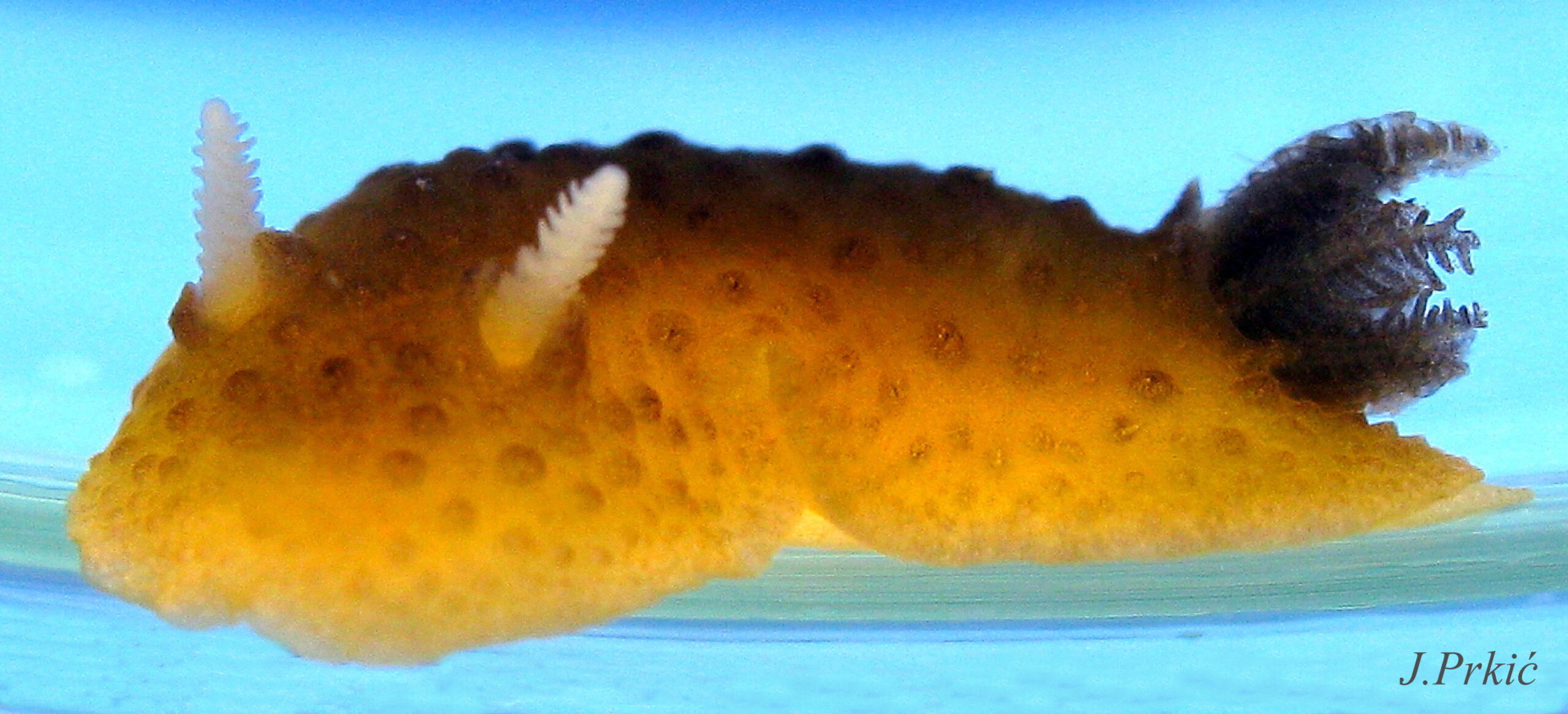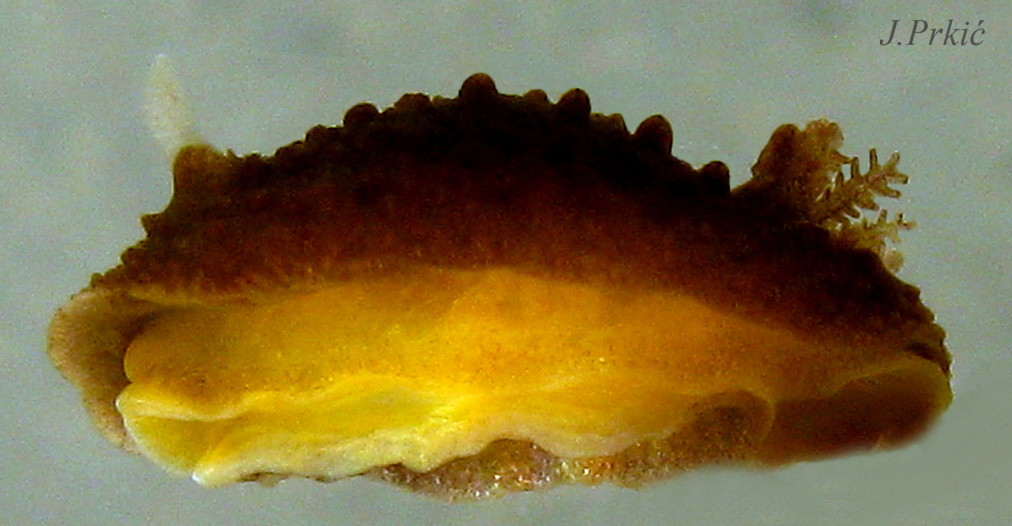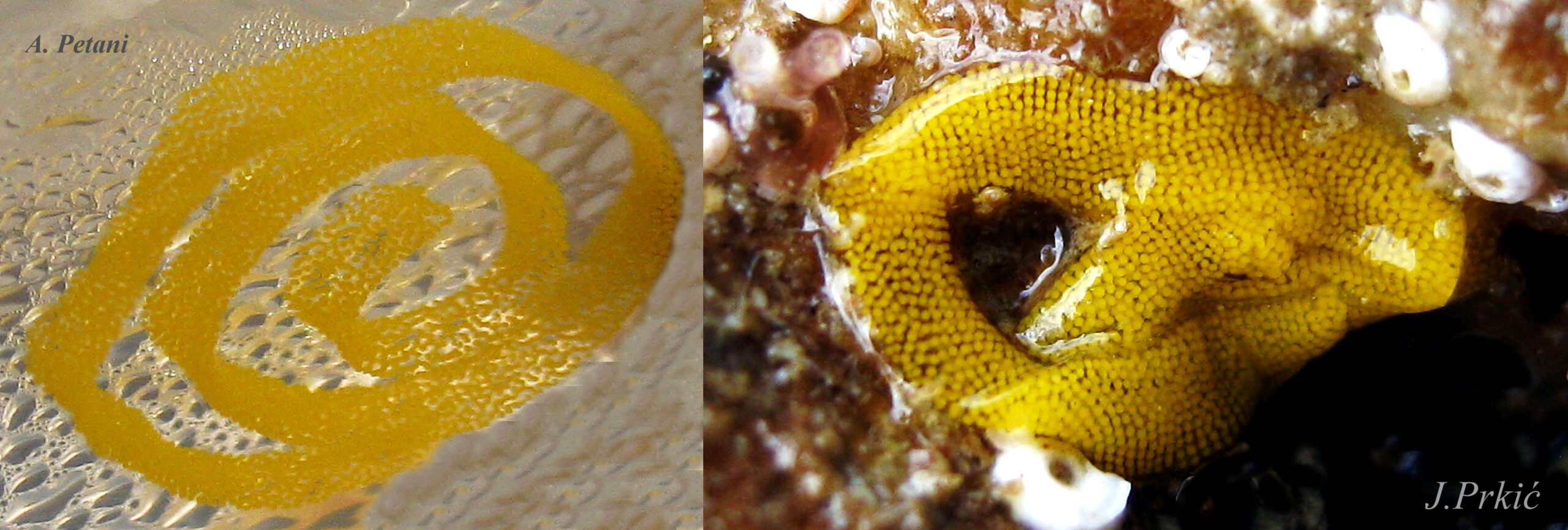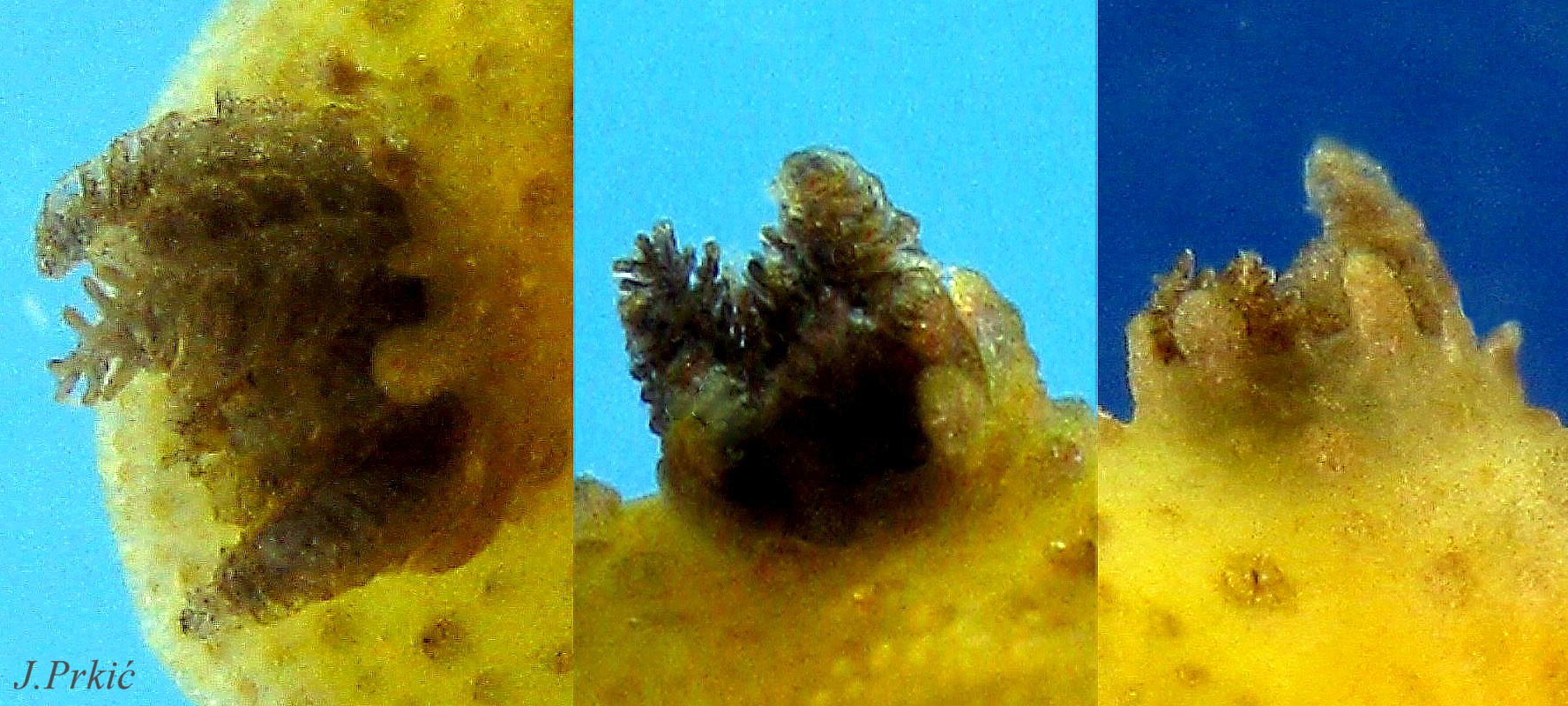Click image to enlarge with full caption. Main text below slider.
Doris verrucosa Linnaeus, 1758
PDF available at www.researchgate.net/publication/367656829_Doris_verrucos…
Synonyms: Staurodoris verrucosa (Linnaeus, 1758) [Not Staurodoris verrucosa Vayssiere, 1901]; Staurodoris verrucosa var. mollis Eliot, 1906; Archidoris granosa Bergh, 1907.
Current taxonomy: World Register of Marine Species www.marinespecies.org/aphia.php?p=taxdetails&id=139623
GLOSSARY BELOW
Description
Maximum body length is 70 mm (Thompson & Brown). The firm, roughly textured mantle has very large tubercles, often swollen up to 4 mm diameter, with a narrow base. They are interspersed with smaller ones of less than 25% their height and diameter 01 Doris verrucosa . The mantle periphery has mainly small tubercles. The tubercles have a smooth surface with no protruding spicules, but they may appear rough when debris adheres to them 02 Doris verrucosa .
The ground colour of the mantle is usually whitish, yellow 03 Doris verrucosa , orange-brown 04 Doris verrucosa , light violet or greyish 05 Doris verrucosa , sometimes with dark dorso-lateral bands or patches 06 Doris verrucosa . The tubercles may be concolorous with the mantle 03 Doris verrucosa & 07 Doris verrucosa or a slightly darker shade 01 Doris verrucosa , and occasionally darkened apically 04 Doris verrucosa .
The rhinophores are concolorous, or nearly so, with the mantle 08 Doris verrucosa & 03 Doris verrucosa . They are sometimes flecked with fine brown spots 09 Doris verrucosa . The stem is swollen when contracted, but forms a continuous cone with the distal lamellate section when fully extended 02 Doris verrucosa . The slender distal half usually has 10 to 13 lamellae 08 Doris verrucosa , maximum 20, which are concolorous with, or a little paler than, the mantle. The stem is translucent and pale or colourless on unpigmented specimens. There are two smooth large spatulate guard-tubercles at the base of each rhinophore 08 Doris verrucosa .
There are up to 18 (Thompson & Brown, 1988) simple unipinnate gill
plumes flic.kr/p/2ocnnQA around the anal papilla. The pinnae alternate long and short along the rachis of the gill plumes. The gills are usually concolorous with the mantle 03 Doris verrucosa or nearly so 06 Doris verrucosa , but sometimes darker 11 Doris verrucosa . The gills are protected by about one large or small spatulate guard-tubercle per plume 06 Doris verrucosa & 07 Doris verrucosa standing on a raised collar.
The head has “short, grooved oral tentacles” (Thompson and Brown 1984) or “flat, rounded oral tentacles form[ing] 2 low ridges” (Schmekel and Portmann, 1982); they probably vary in extension and shape.
The foot is hidden dorsally by the ample mantle.
Key identification features
Doris verrucosa Linnaeus, 1758.
1) Rhinophores concolorous, or nearly so, with the mantle 08 Doris verrucosa & 03 Doris verrucosa ; sometimes flecked with fine brown spots 09 Doris verrucosa . Stem is swollen when contracted, but forms a continuous cone with the distal lamellate section when fully extended 02 Doris verrucosa .
2) Tubercles vary from very small to very large and swollen with narrow bases 01 Doris verrucosa .
3) Spawn is a yellow or white undulated ribbon deposited in a spiral 12 Doris verrucosa ; diameter usually over 20 mm.
4) Ground colour of mantle usually whitish, yellow 03 Doris verrucosa , orange-brown 04 Doris verrucosa , light violet or greyish 05 Doris verrucosa , sometimes with dark dorso-lateral bands 06 Doris verrucosa .
5) Adult length often 40 mm, up to 70mm.
6) Tubercles smooth without protruding spicules, but adhering detritus may give rough appearance 02 Doris verrucosa .
7) Tubercles concolorous with mantle 03 Doris verrucosa & 07 Doris verrucosa or a slightly darker shade 01 Doris verrucosa , occasionally darkened apically 04 Doris verrucosa .
8) Two smooth large spatulate guard-tubercles at base of each rhinophore 08 Doris verrucosa .
9) Gills protected by spatulate guard-tubercles 06 Doris verrucosa & 07 Doris verrucosa .
10) Gills unipinnate and concolorous with the mantle 03 Doris verrucosa or nearly so 06 Doris verrucosa or darker than it 11 Doris verrucosa .
11) Head has short, grooved oral tentacles (Thompson and Brown 1984).
12) Occurs in the Mediterranean and Atlantic coast north to Brittany. First verified record in Britain from Southampton Water in June 2023.
Similar species
Doris adrianae Urgorri & Señarís, 2021.
1) Rhinophores concolorous with mantle.
2) Tubercles are low domes of various sizes but not greatly inflated .
3) Spawn is a slightly greyish, hyaline white, undulating, 5 mm-wide ribbon with a brown upper edge. It is deposited as a spiral of two to two and a half turns.
4) Mantle yellow to orange-yellow.
5) Adult often 40 mm to 55 mm long and 30 mm to 40 mm wide.
6) Tubercles have nodose surface, resembling cauliflower 13 Doris verrucosa COMPARE Doris adrianae . Lattice of radiating spicules within tubercles may be visible, but do not protrude; animal feels very stiff.
7) Tubercles concolorous with mantle, no dark apical mark.
8) Rhinophores have tall sheaths with very small tubercles on their surface, but no spatulate guard-tubercles 13 Doris verrucosa COMPARE Doris adrianae .
9) Gills surrounded at their base by sheath with very small tubercles on
its surface, but no spatulate guard-tubercles 14 Doris verrucosa COMPARE Doris adrianae .
10) Gills translucent whitish with opaque white and dark marks 14 Doris verrucosa COMPARE Doris adrianae . Tripinnate with wide ragged pinnae; arranged around tall, tubular anal papilla 15 Doris verrucosa COMPARE Doris adrianae .
11) Head has two lateral oral lobes.
12) First described in 2021 from Galicia, north-west Spain. Also from Portugal and on mud among detritus at 30 to 40 m depth in Bretagne, France . As only recently recognised it may be more widespread.
Doris ocelligera Mediterranean form.
For details of Atlantic form see full species account (Prkić & Smith, 2023).
The small size of adult D. ocelligera , usual maximum length 15 mm, immediately distinguishes it from D. verrucosa . No specimens or web images of D. verrucosa under 20 mm length have been knowingly viewed.
A characteristic Mediterranean specimen of D. ocelligera has a dark, slightly translucent body with contrasting white rhinophores and dark gills. The tubercles are dark, broad-based domes or cones, frequently with a dark apical spot.
1) The rhinophores have translucent pure-white 16 Doris verrucosa COMPARE Doris ocelligera to yellowish-white lamellae which strongly contrast with the frequently dull or dark mantle.
2) Tubercles vary in number and size with shape ranging from low rounded 17 Doris verrucosa COMPARE Doris ocelligera to conical with obtuse tip 18 Doris verrucosa COMPARE Doris ocelligera , but always widest at base.
3) Spawn, canary-yellow, not undulated, ribbon in loose coil of less than three turns 19 Doris verrucosa COMPARE Doris ocelligera , diameter usually under 10 mm.
4) Large range of mantle colours: usually a dull or dark shade of brown , green 16 Doris verrucosa COMPARE Doris ocelligera or yellow 17 Doris verrucosa COMPARE Doris ocelligera , but occasionally bright yellow, bright orange-yellow , black-grey or blue-grey 16 Doris verrucosa COMPARE Doris ocelligera . Mantle is not usually very translucent, but spicules radiating from tubercles sometimes create a quilted appearance 16 Doris verrucosa COMPARE Doris ocelligera .
5) Mature adults usually 6 mm to 12 mm long, usual maximum 15 mm, very rarely 20 mm at extreme extension,.
6) Seen under magnification in good light, some spicules can be seen protruding from tubercles .
7) Tubercles have dark apical spot on most specimens 16 Doris verrucosa COMPARE Doris ocelligera . Sometimes tubercles entirely dark.
8) Two large spiculose, spatulate guard-tubercles on rim of rhinophore pit 17 Doris verrucosa COMPARE Doris ocelligera .
9) Up to ten spiculose, spatulate guard-tubercles at base of gill 20 Doris verrucosa COMPARE Doris ocelligera .
10) Up to ten unipinnate gills 18 Doris verrucosa COMPARE Doris ocelligera , often much darker than mantle 20 Doris verrucosa COMPARE Doris ocelligera .
11) No linear oral tentacles, but very variable oral-lobe on each side of mouth . Lobe has cavity distally, but often difficult to discern.
12) Precise range limits uncertain; it may extend into the Atlantic in Iberia or intergrade there with the Atlantic form
Habits and ecology
Doris verrucosa occurs intertidally and sublittorally to about 15 m depth (near Naples). It is often found in sheltered areas with much soft sediment such as etangs (lagoons) 05 Doris verrucosa , estuaries, in ports and on beds of Zostera and Cymodocea nodosa (Ucria) Asch. (F. Vitale pers. comm. 7 January 2023 ) 11 Doris verrucosa . On the shore, it is often found under stones or on sponges. It feeds on sponges; faeces examined in Galicia, Spain by Urgorri & Besteiro (1984) had spicules exclusively from Hymeniacidon sanguinea (70%) and Halichondria panicea (30%). It is a simultaneous hermaphrodite, breeding from July to October at Arcachon in south-west France (Thompson & Brown, 1984). The spawn is a yellow 12 Doris verrucosa or white 05 Doris verrucosa undulated ribbon attached by its edge in a spiral of up to five turns with diameter over 20 mm (Poddubetskaia, 2003) .
Distribution and status
D. verrucosa is amphiatlantic occurring in southern Europe from the Mediterranean to Bretagne, from Brazil to Massachusetts, USA and in the Azores(Thompson & Brown, 1984); GBIF map www.gbif.org/species/5190113 Those recorded in southern Africa on iNaturalist www.inaturalist.org/observations?taxon_id=363660 are very similar to D. verrucosa except that the gills seem to be tripinnate instead of simply pinnate.
Twentieth Century records of D. verrucosa in the British Isles are very few and uncertain. There is no evidence available for the improbable ones for Scotland on NBN Atlas species.nbnatlas.org/species/NBNSYS0000175005 . The first verified record in Britain was made by Jenny Mallinson in Southampton Water in June 2023 21 Doris verrucosa .
Acknowledgements
This account relies entirely on images provided by Frédéric Andre, Pierre Corbrion, Paolo Mariottini, Alen Petani, Jakov Prkić, Siôn Roberts, François Roche, João Pedro Silva and Fabio Vitale. I am most grateful to them for making the account possible.
References and links
Doris verruqueuse, Doris verrucosa Linnaeus, 1758. Donnees d’observations pour le reconnaissance et l’identification de la fauna et la flore subaquatique (DORIS). doris.ffessm.fr/Especes/Doris-verrucosa-Doris-verruqueuse…
Koehler, E., Doris verrucosa Linnaeus, 1758 in Sea slugs of the Mediterranean Sea and elsewhere www.medslugs.de/E/Med/Doris_verrucosa/Selection.htm
(accessed January 2023)
Poddubetskaia, M., 2003. Doris verrucosa egg ribbon. [Message in] Sea Slug Forum. Australian Museum, Sydney. www.seaslugforum.net/find/10235
Prkić, J. & Smith, I.F. 2023. Doris ocelligera (Bergh, 1881) Identification and Biology. www.researchgate.net/publication/366988260_Doris_ocellige…
Schmekel, L. & Portmann, A., 1982. Opisthobranchia des Mittelmeeres. Berlin- Heidelberg.
Thompson, T.E. & Brown, G.H. 1984. Biology of opisthobranch molluscs 2. London, Ray Society.
Vitale, F. Doris verrucosa Linnaeus, 1758, Marine Heterobranchia of the Salento Peninsula. (Accessed January 2023) www.salentosommerso.it/pp_nudibranchia/Doris%20verrucosa/…
Urgorri V. & Besteiro C., 1984. La alimentacion de los moluscos nudribranquios de Galicia. The feeding habits of the nudibranchs of Galicia Iberus, part 4: 51-58. archive.org/details/iberusrevista14198184soci/page/52/mod…
Glossary
dorsolateral = at or near junction/merging of dorsal and lateral surfaces.
hermaphrodite, simultaneous = individual acts as both male and female at the same time with similar partner(s).
lamellae = (sing. lamella) small plates on rhinophores, or leaflets of gill.
mantle = (of sea slugs) sheet of tissue forming part or all of notum.
notum = dorsal body surface.
nudibranch = seaslugs in the order Nudibranchia with no shell when adult.
pinna = (pl. pinnae) primary element/leaflet of a pinnate gill, leaf, feather etc.
plankton = animals and plants that drift in pelagic zone (main body of water).
rachis = central shaft/main axis of a feather or gill plume.
rhinophores = chemo-receptor tentacles on top of head of nudibranch.
spicule = small, slender, sharp-pointed feature mainly composed of calcite (CaCO3) and brucite (Mg(OH)2) .
tripinnate = (of gill plume) threefold branching; “boughs, branches, twigs” in one plane like a feather.
unipinnate = (of gill plume) branching singly; boughs but no subsequent branches or twigs, in one plane like a feather.
